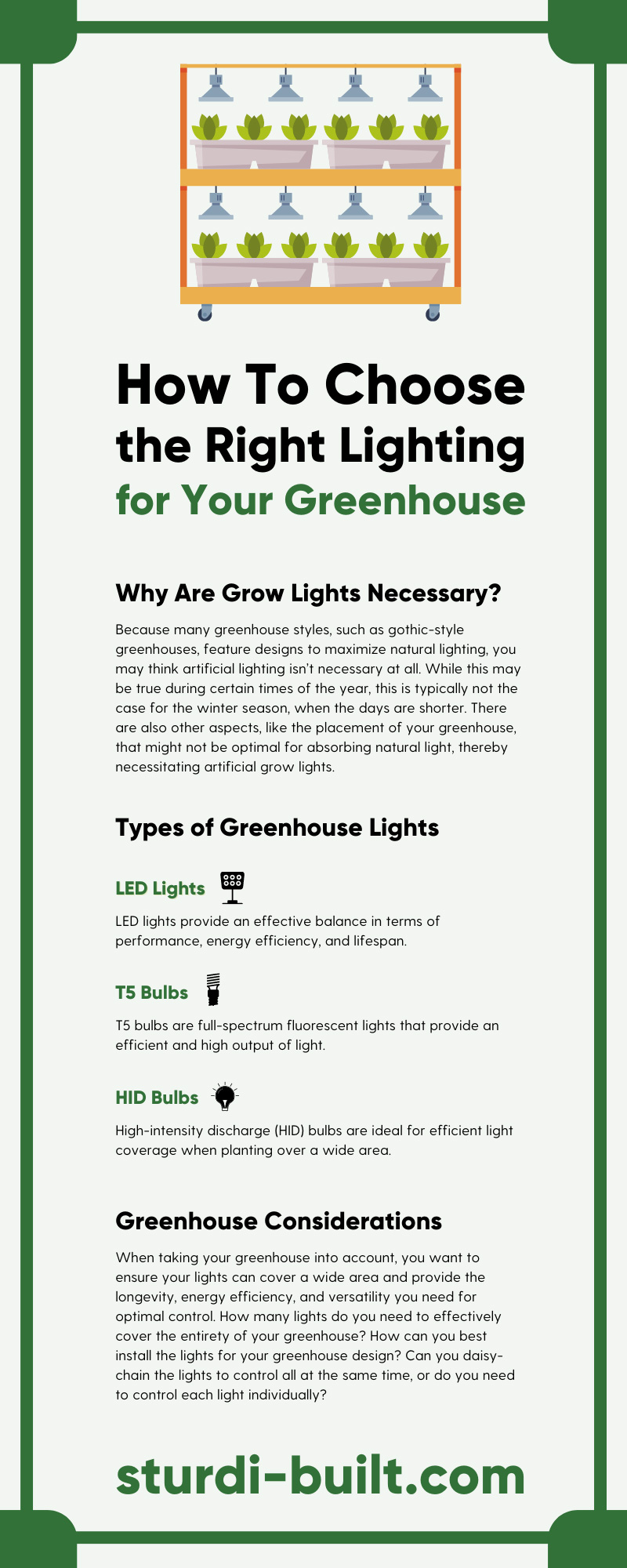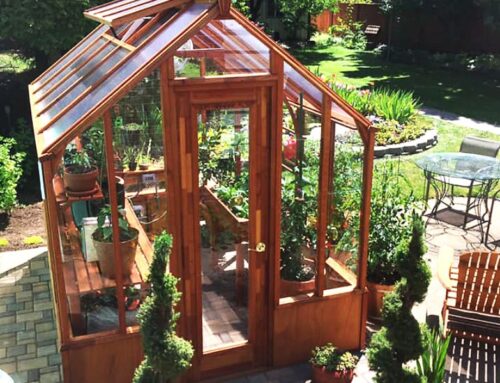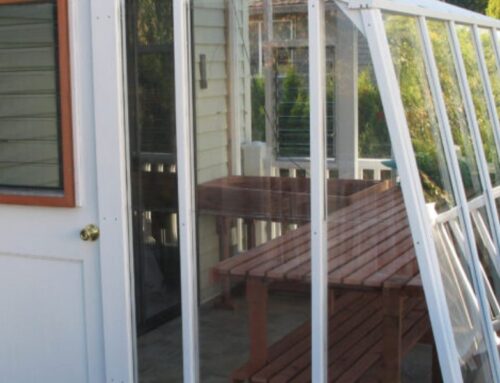Greenhouses afford you complete control over your plants’ growing conditions, allowing you to customize aspects like climate, humidity, and most importantly, light. Though greenhouses typically receive plenty of natural light, you probably also need to supplement with grow lights for optimal control. Read on to learn about how to choose the right lighting for your greenhouse based on aspects like illumination, light spectrum, and much more.
Why Are Grow Lights Necessary?
Because many greenhouse styles, such as gothic-style greenhouses, feature designs to maximize natural lighting, you may think artificial lighting isn’t necessary at all. While this may be true during certain times of the year, this is typically not the case for the winter season, when the days are shorter. There are also other aspects, like the placement of your greenhouse, that might not be optimal for absorbing natural light, thereby necessitating artificial grow lights.
Furthermore, as you become a veteran at cultivating plants, you’ll also need grow lights that fulfill the specific wavelengths of light your plants need for truly optimal conditions. Not all light is equal when it comes to nurturing plants, so eventually, natural light alone won’t be adequate if you want to go the distance with your greenhouse.
You also shouldn’t make the mistake of using household incandescent lightbulbs. These are less effective, and the heat they generate can be damaging to your plants unless they’re located a long distance away. In turn, this makes it difficult to effectively cover all your plants and provide them with the light they need.
Types of Greenhouse Lights
There are a lot of different grow lights for you to choose from, but to help newcomers get started, we’ll be looking at only the most common greenhouse lights. However, just because these lights are popular doesn’t mean they’re inferior or limited. These lights will still provide you with promising results as you experiment.
LED Lights
LED lights provide an effective balance in terms of performance, energy efficiency, and lifespan. Popular amongst beginners and veterans alike, LED lights don’t produce nearly as much heat as other bulbs, so they pose far less of a risk to your plants. This lack of heat generation also means you can leave LED lights on for long periods of time without having them become a potential fire hazard. Furthermore, their efficient use of energy means that the lifespan of LED bulbs is greatly increased over traditional bulbs, typically lasting for about 11 years. Cost-wise, you also won’t be drastically raising your energy bill from having the LEDs run for long hours.
Available in colors like red and blue, LED lights help ensure your plants get the spectrum of light that is most nourishing, helping them grow stronger and lusher than ever. Because LED lights have become so commonplace, they’re also one of the more accessible options when choosing the right lighting for your greenhouse.
T5 Bulbs
T5 bulbs are full-spectrum fluorescent lights that provide an efficient and high output of light. Like LEDs, these bulbs are more energy efficient than traditional incandescent bulbs and feature a typical lifespan of 50,000 hours. While many plants are nourished with red or blue light, fluorescent has a deeper penetration, which can often benefit your plants.
HID Bulbs
High-intensity discharge (HID) bulbs are ideal for efficient light coverage when planting over a wide area. The biggest drawback of these lights is that they can generate a great deal of heat. Therefore, you will need to install them at a distance to prevent leaf burn. In terms of light spectrum, there are two kinds of HID bulbs to choose between:
- High-pressure sodium bulbs: these emit a lot of red light that is beneficial for flowering and budding.
- Metal halide bulbs: in contrast, these emit plenty of blue light to stimulate bushy growth.
Which Is Best?
Overall, LED lights will provide the best coverage for all your plants’ needs while you’re still learning. However, T5 and HID bulbs are just as viable, provided you understand what kind of light your plants need to grow.
Greenhouse Considerations
When taking your greenhouse into account, you want to ensure your lights can cover a wide area and provide the longevity, energy efficiency, and versatility you need for optimal control. How many lights do you need to effectively cover the entirety of your greenhouse? How can you best install the lights for your greenhouse design? Can you daisy-chain the lights to control all at the same time, or do you need to control each light individually?
You also want to ensure the lights you buy are waterproof, so they can withstand general greenhouse humidity and when you water your plants. lights that aren’t properly sealed will malfunction when exposed to precipitation that lets water get into the delicate components of the lights.
Low-Light vs. Full-Sun Plants
You probably want to be able to control individual lights to accommodate the varying needs of your distinct plants. Not every plant benefits from getting as much light as possible, so you’ll need to consider what you’re growing and whether you need low-light or full-sun lights. For example, tropical plants don’t need as much direct sunlight in comparison to plants like tomatoes. To compensate, you can either place the grow lights further away from their growth canopy or ensure their lights aren’t running as often throughout the day.
Full-sun plants like tomatoes, however, will need 12–16 hours of direct sunlight every day to grow healthy and strong. Because these plants need a near-constant light source, LED lights are often ideal because they’re energy-efficient and don’t generate a lot of heat.
Adjusting for Plant Stages
Lastly, the light your plants need isn’t static. As seedlings, many plants will prosper more from blue light, while plants that are getting ready to bloom or produce food benefit far more from red light. You can customize some LEDs to change color as necessary. Otherwise, you’ll want to find appropriate HID bulbs that you can switch to whatever’s appropriate for your plants’ current growth stages.
For all your greenhouse needs, contact Sturdi-Built Manufacturing, one of the leading manufacturers of redwood greenhouses! We’ll be happy to help you explore your lighting options and figure out what lights best suit your needs.











Leave A Comment